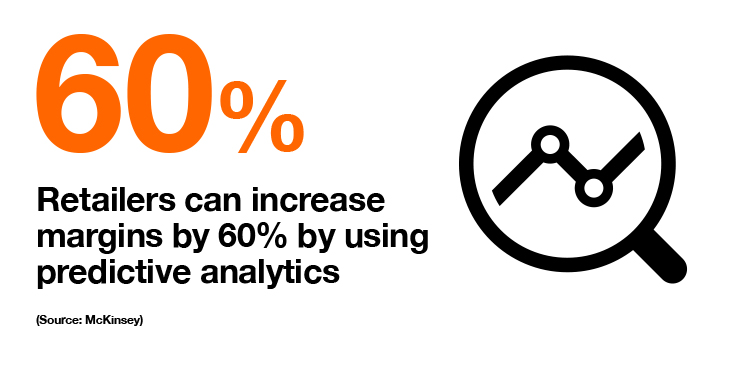Knowing what your customers might want to do or buy next can give companies a significant competitive advantage. Predictive analytics can help you enhance personalization, drive new business and increased loyalty, and improve customer experience (CX) overall.
Over the past year, the absence of physical shopping possibilities and in-person services has driven consumers to use digital channels to interact with brands more than ever. Many consumers hadn’t used digital to engage with brands previously: McKinsey reported that 75% of U.S. consumers tried a new brand or way of shopping in 2020. According to Forrester, digital customer service interactions will increase by 40% this year. Clearly, consumers have grown to like these digital channels and will continue using them moving forward.
This presents brands with an opportunity, because the increase in engagements via digital channels means more data generated. And that data can be leveraged to drive customer satisfaction and increased loyalty. Predictive analytics can help you achieve the holy grail of customer service: knowing what your customers want even before they do. And it contributes greatly to your ability to give them an enhanced level of CX.

How does it work?
Predictive analytics lets you target and retain customers by using data, statistical algorithms, artificial intelligence (AI) and machine learning (ML) tools to predict the probability of future outcomes. It empowers you to transform existing data into future insights.
Further, it works by consolidating existing and historical customer data alongside what customers are talking about on social media and other public platforms. From that, suppliers can tailor offers in new ways and deliver enhanced CX via multiple different channels. Predictive analytics lets you create personalized content, information, products and services that consumers expect, even before they know they want it.
Enhancing CX with targeted improvements
The rise of big data, alongside AI and ML, plus a more technology-savvy consumer who demands a more personalized experience, has made predictive analytics a must have. Some examples of specific ways predictive analytics can enhance CX include:
1. Knowing what customers want helps keep them loyal
Once you’ve attracted a new customer, you want to keep them coming back. And every engagement you have with that customer, whether through them buying something, asking you questions or receiving customer support, is an opportunity to know them better. Gathering data from past interactions with customers, their social media and online reviews helps you create insights and transform interactions into personalized engagements.
According to research done by Frederick Reichheld of Bain & Company, the inventor of the net promoter score, increasing customer retention rates by 5% increases profits by 25-95%. Customer retention is essential, and Microsoft has found that 96% of customers say customer service is important in their choice of loyalty to a brand.
2. Predicting potential churn
Predictive analytics can enable churn modeling, a technique used to identify customers who might be at risk of leaving – and then help companies work to retain them. It’s a method commonly used by cell phone companies, or indeed any subscription-based business model, such as insurance firms or energy companies.
Where customer attrition analysis and customer churn rates are a key business metric, being able to predict potential churn and tailor offerings towards keeping that customer is powerful. According to McKinsey, a comprehensive, analytics-driven approach can help telecom companies reduce churn by as much as 15%.
3. Building customer segments to predict patterns
Customer segmentation lets you group customers with similar profiles and build offerings that can be promoted to both existing and new customers. Traditionally, manually segmenting customers has been a time-consuming process and one not very well-suited to bulk data. AI and ML can segment customer bases much more effectively, using historical data to form connections and decide how customers will likely react to certain offerings.
Predictive analytics tools empower you with knowledge of how responsive customers in each segment might be to different stimuli. You can establish what criteria might have made customers in a segment make a purchase decision. And you can work out how much to promote to companies in each segment to maximize efficiency. All this feeds into predicting patterns, which creates a more personalized and effective CX.
4. Personalized experiences through anticipation of needs
Predictive analytics helps companies target and retain customers by creating a proactive and personalized CX. By predicting customers’ needs and patterns, you can work out where to deliver the most value to customers at the most significant stage of their journey with you. Anticipation is key to personalization: give your customers what they want practically before they realize they want it.
According to McKinsey, personalization leaders can drive 5% to 15% increases in revenues by deploying product recommendations and triggered communications within singular channels powered by predictive analytics.
Predicting the future to take CX to the next level
If CX is indeed the new competitive battleground, companies will need as many weapons as possible in their armories to succeed. Predictive analytics is already a key technique and, according to research, helps retailers increase margins by up to 60%. This figure will probably grow as data analytics tools, AI and ML extend their capabilities. Forrester predicts that a quarter of brands will make significant advances in the quality of their CX in 2021, and predictive analytics will be a central pillar of that.
Read on to discover the value in personalized customer experience, future trends in customer experience, and how you can leverage analytics to monetize your data.